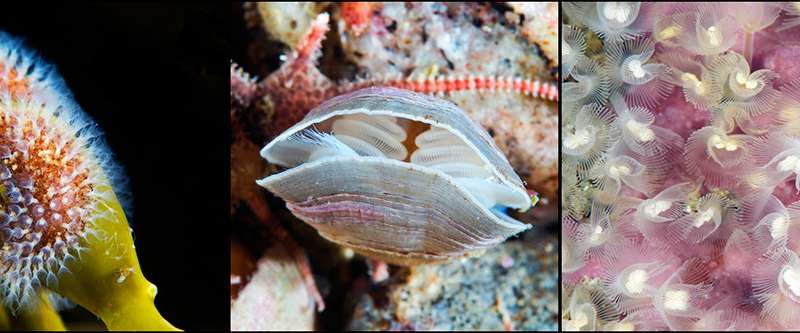The final three phyla in this chapter are the most controversial taxa placed within Protostomia. Evidence that Ectoprocta, Brachiopoda, and Phoronida belong within the lophotrochozoan subgroup of protostomes comes from sequence analysis of the genes encoding small-subunit ribosomal RNA. Some developmental data are consistent with the molecular data: in phoronids, the blastopore becomes the mouth, as is typical for protostomes, but in brachiopods, the blastopore disappears and both mouth and anus develop from new openings. Ectoproct cleavage appears to be mosaic, another protostome feature.
Other aspects of development support placement of these taxa within Deuterostomia: cleavage is radial in all three phyla, and each has a coelom formed by enterocoely. As in some deuterostomes, the coelom is divided into three parts: protocoel, mesocoel, and metacoel. Members of all three phyla possess a feeding device called a lophophore (Gr. lophos, crest or tuft, + phorein, to bear). A lophophore is a unique arrangement of ciliated tentacles borne on a ridge or fold of the body wall. The tentacles are hollow and contain an extension of the mesocoel. Thus, the thin ciliated tentacles are not only an efficient feeding device, but also a respiratory device permitting gas exchange between the surrounding water and the internal coelomic fluid. The lophophore and its crown of tentacles can usually be extended for feeding or withdrawn for protection.

The gut is U-shaped, with the mouth opening inside the lophophore ring, and the anus opening outside the ring . A flap of tissue, the epistome, covers the mouth and contains an extension of the protocoel. The regions of the body housing the mesocoel and metacoel are called the mesosome and metasome, respectively. In Ectoprocta, the fluid-filled mesocoel and metacoel cavities are part of the hydraulic system for lophophore extension. In other groups the metacoel houses the viscera.

At various points in history, Ectoprocta, Brachiopoda, and Phoronida have been considered protostomes with some deuterostome characteristics or deuterostomes with some protostome characteristics. Their current placement as lophotrochozoan protostomes reflects acceptance of molecular data in the face of conflicting and inconsistent morphological data.
In some classification schemes, the shared presence of a lophophore is used to unite all three phyla into a lophophorate clade. We do not present this scheme. Both molecular and morphological evidence support the placement of Brachiopoda and Phoronida as each other’s closest relatives, but the position of Ectoprocta is less clear. It may belong with the other two phyla, but a detailed analysis of lophophore function 2 suggests otherwise. A lophophore is well suited to capturing suspended food particles from the surrounding water—is the ectoproct lophophore convergent to that of brachiopods and phoronids? Much remains to be discovered about these odd animals.
Useful External Links
- Morphology evidences the lophophorates monophyly: Brief review of studies on the lophophore innervation by Elena Temereva
- Innervation of the lophophore suggests that the phoronid Phoronis ovalis is a link between phoronids and bryozoans by Elena N. Temereva
- Lophophorate Phylogeny by B. L. Cohen


